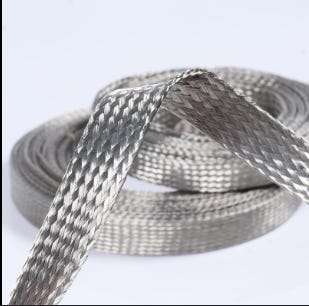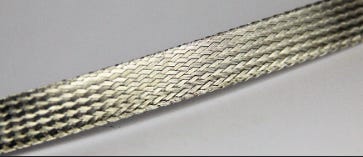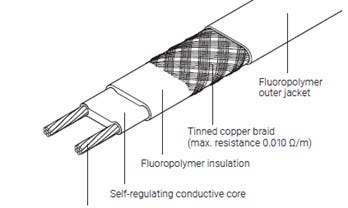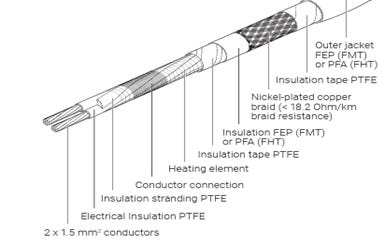Protective Braids: Enhancing Reliability and Safety in Heat Tracing Cables
Strengthening Heat Tracing Systems with Advanced Protective Braids
Abstract
Protective braids are an integral component of electric heat tracing cables, encasing the insulation and providing critical functionalities. These braids, typically composed of metallic strands, enhance the durability, safety, and performance of heat tracing systems. As the outermost shield, they play a vital role in the overall reliability and efficiency of heat tracing solutions in industrial environments.
What is a Protective Braid?
A protective braid is a woven metallic layer that surrounds the insulation of electric heat tracing cables. It is typically made from tinned copper or nickel-plated copper and serves multiple functions, including mechanical protection, electrical grounding, and shielding from electromagnetic interference. By reinforcing the structural integrity of the cable, the protective braid ensures durability in harsh environments, prevents electrical hazards, and extends the operational lifespan of heat tracing systems.
Why We Need Protective Braids
In industrial settings, electric heat tracing cables are exposed to challenging conditions such as mechanical stress, electrical interference, and corrosive environments. Protective braids address these challenges by serving as a multi-functional shield that ensures the reliability and safety of the cables. The absence of braids can lead to frequent cable failures, increased downtime, and potential safety hazards, making them indispensable in heat tracing systems.
Implications of Absence: Without protective braids, cables would be vulnerable to:
Physical Wear:
In the absence of braids, cables are directly exposed to mechanical stress during installation or operation. Activities such as pulling, bending, or dragging the cables can cause abrasion or cuts to the insulation. Over time, this can compromise the insulation layer, exposing the internal conductors and resulting in failures or hazards.
Electrical Hazards:
The lack of a protective braid removes a crucial grounding mechanism. Stray electrical currents, caused by faults or interference, will have no safe pathway to dissipate, increasing the likelihood of short circuits or electric shocks. This is particularly dangerous in hazardous zones, where even minor electrical faults can lead to catastrophic incidents such as fires or explosions.
Increased Electromagnetic Interference:
In environments with high electrical noise, unshielded cables are prone to interference, which can disrupt their functionality. The absence of braids leaves the cables unprotected from external electromagnetic waves, causing erratic performance or failure of the heat tracing system.
Accelerated Corrosion and Degradation:
Protective braids, especially those made of nickel-plated copper or stainless steel, act as barriers against corrosive chemicals. Without them, the cables’ insulation and core are directly exposed to harsh environments, such as chemical plants or offshore locations. This exposure leads to rapid deterioration of the cable’s structural integrity, necessitating frequent replacements and increasing operational costs.
Shortened Operational Life:
The combined effects of physical wear, electrical hazards, and chemical exposure significantly reduce the lifespan of unbraided cables. Frequent failures disrupt operations, leading to costly downtime and repairs, making the absence of protective braids a critical limitation in industrial applications.
Functionality of Braids
Mechanical Protection
Protective braids act as a physical barrier that safeguards the cable from external mechanical stress. During installation, cables are often dragged, bent, or compressed, which can lead to abrasion or damage to the insulation. The braid absorbs and disperses these stresses, preventing the underlying insulation and internal components from sustaining damage. In operation, they also protect against impacts or contact with sharp edges, ensuring the cable maintains its structural integrity in rugged environments.
Electrical Grounding
Metallic braids, made from conductive materials such as tinned or nickel-plated copper, provide an effective grounding path. Stray electrical currents can arise from faults or electrical noise, posing risks of electric shocks or short circuits. The braid captures these stray currents and directs them safely to the ground, ensuring compliance with safety standards and reducing the likelihood of hazardous situations, especially in explosive or hazardous zones.
Electromagnetic Shielding
In environments with high electrical activity, such as industrial plants or refineries, electromagnetic interference (EMI) can disrupt the performance of sensitive electronic equipment. The braid acts as a shield, blocking external electromagnetic waves from affecting the cable’s performance. This ensures stable and reliable operation of the heat tracing system, which is critical for maintaining process temperatures or preventing frost damage.
Chemical Resistance:
Protective braids made from materials such as nickel-plated copper or stainless-steel resist corrosive chemicals. Heat tracing cables in chemical plants, offshore platforms, or refineries are often exposed to aggressive substances like acids, alkalis, or solvents. The braid prevents these chemicals from reaching the insulation or core, thereby extending the operational lifespan of the cable and reducing the need for frequent replacements.
Types of Protective Braids by Material
Tinned Copper Braids
Description: Made from strands of copper coated with a layer of tin to resist oxidation and corrosion.
Advantages: Tinned copper braids are cost-effective, provide excellent electrical conductivity, and offer moderate resistance to environmental factors such as moisture and corrosion.
Best Conditions: These braids are ideal for applications involving moderate environmental exposure, such as frost protection or temperature maintenance in relatively controlled industrial environments.
Example: The QTVR self-regulating cables employ tinned copper braids, ensuring reliability in frost protection and temperature maintenance.
Nickel-Plated Copper Braids
Description: Copper strands coated with nickel for enhanced chemical resistance and high-temperature performance.
Advantages: Nickel-plated copper braids are highly resistant to aggressive chemicals and can withstand extreme temperatures, making them suitable for high-performance industrial applications.
Best Conditions: These braids are best used in environments with high temperatures or exposure to aggressive chemicals, such as process temperature maintenance in chemical plants or refineries.
Example: The XPI polymer-insulated cables use nickel-plated copper braids, allowing operation at temperatures up to 260°C.
Applications for Braid Types
Self-Regulating Cables: These cables adjust their power output based on ambient temperature, making them energy efficient.
Examples:
10QTVR2-CT: A self-regulating cable with tinned copper braids, designed for frost protection on large pipes and storage tanks. This cable excels in HVAC systems due to its ability to adjust power output based on changing ambient temperatures, ensuring energy-efficient operation.
15QTVR2-CT: Features the same tinned copper braid but with higher power output. It is ideal for applications requiring moderate temperature maintenance, such as chemical processing plants where maintaining a specific fluid viscosity is critical.
Industries: HVAC systems, food processing facilities, and medium-scale chemical industries.
Reason for Excellence: Tinned copper braids enhance corrosion resistance while the self-regulating functionality prevents overheating and minimizes energy consumption.
Constant Wattage Cables: These include the FHT cables, which use nickel-plated copper braids for high-temperature applications.
Examples:
20FHT2-CT: This cable provides consistent wattage and includes nickel-plated copper braids that enhance durability in environments with steam purges. It is suitable for maintaining pipeline temperatures in pharmaceutical and chemical industries.
30FHT2-CT: Offers higher wattage output, making it suitable for process temperature maintenance in refineries, where consistent heating is necessary to prevent solidification of crude oil.
Industries: Refineries, pharmaceutical plants, and heavy chemical manufacturing.
Reason for Excellence: Nickel-plated copper braids provide resilience against chemical attacks and high temperatures, ensuring the cables can operate effectively under harsh conditions.
Comparison of Braid Types
Conclusion
Protective braids are indispensable for ensuring the efficiency and safety of electric heat tracing cables. By selecting the appropriate braid material based on application requirements—whether it’s tinned copper for general use, nickel-plated copper for high temperatures, or stainless steel for extreme environments—industries can maximize the performance and lifespan of their heat tracing systems. In self-regulating cables, the synergy between the cable’s core functionality and the protective braids underscores their critical role in advancing heat tracing technology.
References
RAYCHEM-DS-EU1381-QTVR-EN
https://www.nvent.com/en-bo/raychem/products/qtvr-self-regulating-heating-cable-0
RAYCHEM-DS-EU1750-HTV-EN
https://www.nvent.com/en-bo/raychem/products/htv-self-regulating-heating-cable-0
RAYCHEM-DS-EU1380-BTV-EN
https://www.nvent.com/en-bo/raychem/products/btv-self-regulating-heating-cable-0
RAYCHEM-DS-EU1385-FMTFHT-EN:
https://www.nvent.com/en-sk/raychem/products/fht-constant-wattage-parallel-heating-cable-0







